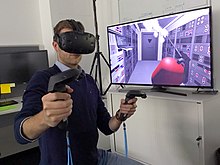User:CheeseSauce15/sandbox

Ready For Grading
Received no feedback
Immersive virtual reality is a technology that aims to completely immerse the user inside the computer generated world, giving the impression to the user that they have "stepped inside" the synthetic world.[1] This is achieved by either using the technologies of Head-Mounted Display(HMD) or multiple projections. HMD allows VR to be projected right in front of the eyes and allows users to focus on it without any distraction.[2] The earliest attempts at developing immersive technology date back to the 1800's. Without these early attempts, the world of immersive technology would never have reached its advanced technological state we have today. The many elements that surround the realm of immersive technology all come together in different ways to create different types of immersive technology including virtual reality and pervasive gaming.[3] While immersive technology has already had an immense impact on our world, its progressive growth and development will continue to make lasting impacts among our technological culture.
Origin
One of the first devices that was designed to look like and function as a virtual reality headset was called a stereoscope. It was invented in the 1830's during the early days of photography, and it used a slightly different image in each eye to create a kind of 3D effect.[4] Although as photography continued to develop in the late 1800's, stereoscope's became more and more obsolete. Immersive technology became more available to the people in 1957 when Morton Heilig invented the Sensorama cinematic experience that included speakers, fans, smell generators, and a vibrating chair to immerse the viewer in the movie.[2] When one imagines the VR headsets they see today, they must give credit to The Sword of Damocles which was invented in 1968 and allowed users to connect their VR headsets to a computer rather than a camera. In 1991, Sega launched the Sega VR headset which was made for arcade/home use, but only the arcade version was released due to technical difficulties.[2] Augmented reality began to rapidly develop within the 1990's when Louis Rosenberg created Virtual Fixtures, which was the first fully immersive augmented reality system, used for the Air Force. The invention enhanced operator performance of manual tasks in remote locations by using two robot controls in an exoskeleton.[2] The first introduction of augmented reality displayed to a live audience was in 1998, when the NFL first displayed a virtual yellow line to represent the line of scrimmage/first down. In 1999, Hirokazu Kato developed the ARToolkit, which was an open source library for the development of AR applications. This allowed people to experiment with AR and release new and improved applications.[2] Later, in 2009 Esquire's magazine was the first to use a QR code on the front of their magazine to provide additional content. Once The Oculus came out in 2012, it revolutionized virtual reality and eventually raised 2.4 million dollars and began releasing their pre-production models to developers. Facebook purchased Oculus for 2 billion dollars in 2014, which showed the world the upward trajectory of VR.[2] In 2013, Google announced their plans to develop their first AR headset, Google Glass. The production stopped in 2015 due to privacy concerns, but relaunched in 2017 exclusively for the enterprise. In 2016, Pokemon Go took the world by storm and became one of the most downloaded apps of all time. It was the first augmented reality game that was accessible through ones phone.
Elements of Immersive Technology

A full immersive technology experience happens when all elements of sight, sound, and touch come together. A true immersive experience needs to be done with either virtual reality or augmented reality, as these two types utilize all of these elements.[5] Interactivity and connectivity is the entire focus of immersive technology. It is not placing someone in an entirely different environment, it is when they are virtually presented with a new environment and are given the opportunity to learn how to optimally live and interact with it.
Types of Immersive Technology
[edit]Virtual reality is the primary source of immersive technology that allows the user to be completely immersed in a fully digital environment that replicates another reality.[6] Users must use a headset, hand controls, and headphones in order to have a fully immersive experience where one is able to utilize movements/reflects.[3]There are also pervasive games which utilize real world locations within game play.[6] This is when the users interaction on a virtual game lead to them interacting in real life. Some of these games may require users to physically meet up in order to complete stages.[6] The gaming world has developed a series of popular virtual reality videogames like, Vader Immortal, Trover Saves The Universe, No Man's Sky, and much more.[7] The world of immersive technology has many facets that will continue to develop/expand over time.
Immersive Technology Today
Immersive technology has grown immensely in the past few decades, and is continuing to progress. VR has even been described as the learning aid of the 21st century.[8] Head mounted displays(HMD) is what allows users to get the full immersive experience. The HMD market is expected to be worth over 25 billion USD by the year 2022.[8] The advanced capabilities and relatively reduced costs of these head sets are now catching the attention of more and more people. Perhaps most notably, Mark Zuckerberg, founder/creator of Facebook, who bought Oculus for 2 billion USD in 2014.[9] Recently, the Oculus quest was released, which is wireless and allows users to move more freely. It costs around 400 USD which is around the same price as the previous generation headsets with cables.[8] Other massive corporations such as, Sony, Samsung, HTC are also making huge investments into VR/AR.[9] In regards to education, there are currently many researchers who are exploring the benefits and applications of virtual reality in the classroom.[8] However, there is little systemic work that currently exists regarding how researchers have applied immersive VR for higher education purposes using HMD's.[8] The most popular use of immersive technology comes in the world of videogames. Completely immersing users into their favorite game, HMD's have allowed individuals to experience the realm of videogames in an entirely new light.[7] Current videogames such as Star Wars: Squadron, Half-Life: Alyx, and No Man's Sky are giving users the ability to experience every aspect of the digital world in their game.[7] While there is still a ton to learn about immersive technology and what it has to offer, it has came an entirely long way from its beginning on the early 1800's.

References
- ^ Furht, Borko, ed. (2008), "Immersive Virtual Reality", Encyclopedia of Multimedia, Boston, MA: Springer US, pp. 345–346, doi:10.1007/978-0-387-78414-4_85, ISBN 978-0-387-78414-4, retrieved 2021-02-22
- ^ a b c d e f "An Introduction to Immersive Technologies". Vista Equity Partners. 2020-02-28. Retrieved 2021-03-22.
- ^ a b "Immersive Technology & Experiences | Transforming How We Do Business". Future Visual. 2020-07-02. Retrieved 2021-03-28.
- ^ "The origins of immersive technologies". FutureLearn. Retrieved 2021-03-22.
- ^ Sachidanand, Rishab (2019-11-20). "Elements of a true immersive experience: comparing altered reality technologies". Medium. Retrieved 2021-03-28.
- ^ a b c "5 Types of Immersive Technology". Simplicable. Retrieved 2021-03-28.
- ^ a b c Hood, Vic; Knapp, Mark; February 2021, Dan Griliopoulos 27. "Best VR games 2021: the top virtual reality games to play right now". TechRadar. Retrieved 2021-03-07.
{{cite web}}: CS1 maint: numeric names: authors list (link) - ^ a b c d e "Elsevier Enhanced Reader". reader.elsevier.com. Retrieved 2021-04-09.
- ^ a b Cipresso, Pietro; Giglioli, Irene Alice Chicchi; Raya, Mariano Alcañiz; Riva, Giuseppe (2018-11-06). "The Past, Present, and Future of Virtual and Augmented Reality Research: A Network and Cluster Analysis of the Literature". Frontiers in Psychology. 9. doi:10.3389/fpsyg.2018.02086. ISSN 1664-1078. PMC 6232426. PMID 30459681.
{{cite journal}}: CS1 maint: unflagged free DOI (link)
